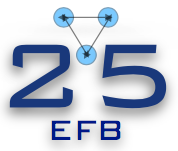Speaker
Description
Low-energy antiprotons are known to be promising tools to probe the nuclear structure [1]. In particular, the measurement of antiprotonic atom decays and nucleon-antinucleon annihilation products is expected to provide reliable data to study the tail of nuclear densities, which has motivated the antiProton Unstable Matter Annihilation (PUMA) project [2] at CERN. Although a qualitative picture of what will happen in the PUMA experiments is known, a fully microscopic treatment of the antiproton-nucleus systems remains to be developed. Our main aim is to solve the few-body Schrodinger equation for the cases accessible by ab initio methods. It is also of paramount importance to test the model-dependence of physical observables relative to the nucleon-nucleon and nucleon-antinucleon interactions input.
Optical potentials are traditionally used to account for the complex annihilation dynamics [3]. We considered an alternative approach based on a coupled-channel potential, where the annihilation is modelled by the addition of effective meson channels [4]. The model-dependence is investigated by considering the microscopic calculation of the antiproton-deuteron annihilation: the scattering lengths and the resonance energies of the antiprotonic states are computed by solving the Faddeev equations in configuration space [5], and then compared to those obtained with optical models [6].
References
[1] J. Eades and F. J. Hartmann. Review of Moderns Physics 71 (1999) 373.
[2] T. Aumann et al.. The European Physical Journal A 58 (2022) 88.
[3] C. B. Dover, T. Gutsche, M. Maruyama, and A. Faessler. Progress in Particle and Nuclear Physics 29 (1992) 87.
[4] E. Ydrefors and J. Carbonell. The European physical journal A 57 (2021) 303.
[5] L. D. Faddeev. Soviet Physics JETP 39 (1960) 1459
[6] R. Lazauskas and J. Carbonell. Physics Letters B 820 (2021) 136573 ; P.-Y. Duerinck, R. Lazauskas, and J. Carbonell. Physics Letters B 841 (2023) 137936 (corrigendum).

